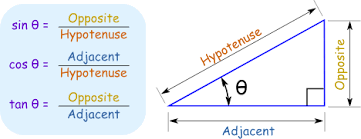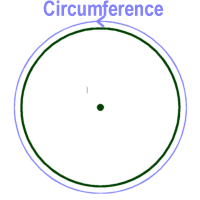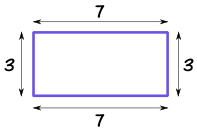 Alfred Ajibola
- Tue, 21st May, 2019 @ 3:42 PM
Alfred Ajibola
- Tue, 21st May, 2019 @ 3:42 PM
Topics in Mathematics
Angles: Type of angles based on degree measurement Angle Pairs: Types of angle pairs Conversion of Number Bases explained with examples Angles: What are Angles? Categories of Angles Lines and Types in Mathematics Number Base System - Table showing the Number Bases with explanations Mathematics Scheme of Work, SS1, 3rd Term Mathematics Scheme of Work, SS1, 2nd Term Mathematics Scheme of Work, SS1, 1st Term Trigonometry - Sine, Cosine and Tangent explained with worked examples Quadratic Equation - Factorization of Quadratic Equation Algebra - Explanation and Worked Examples on AlgebraAcademic Questions in Mathematics

What type of polygon is shown in the above image?
A. Nonagon
B. Decagon
C. Octagon
D. Hexagon
E. Hepagon
F. Pentagon
Which of the following is not part of a circle?
A. Section
B. Sector
C. Segment
D. Semicircle
E. Secant
F. Center

What angle is shown in the above image?
A. Complementary
B. Supplementary
C. Acute
D. Obtuse
E. Reflex
F. Straight
An angle greater than 90o but less than 180o is termed _____.
A. Complementary
B. Supplementary
C. Acute
D. Obtuse
E. Reflex
F. Straight
Factorize 12a2 - 20a + 3
A. (6a - 1)(2a - 3)
B. (6a - 1)(2a + 3)
C. (6a + 1)(2a - 3)
D. (6a + 1)(2a + 3)
E. (-6a + 1)(2a - 3)
F. (-6a + 1)(2a + 3)
Simplify 10ab + 7ab
A. 17ab2
B. 17a2b2
C. 3ab2
D. 3a2b2
E. 17ab
F 3ab
Which of the following is not a type of angle?
A. Right angle
B. Left Angle
C. Acute Angle
D. Complete Angle
E. Straight Angle
F. Reflex angle
Two lines that can never meet each other are best considered as _____ lines.
Numbering begins with 0 (zero). Also, numbers are expressed in bases (sometimes called radix). A base 10 number for instance will comprise of 10 digits ranging from 0 – 9.
Note: We generally use base 10 in our numbering system.
Base 10 digits will comprise of: 0 1 2 3 4 5 6 7 8 9
Since the above numbers are composed of 10 digits, Base 10 may be referred to as decimals or denary digits.
The table below illustrates base 10 digits:
|
Unary or Base 1 |
Base 10 |
Sumary |
|
|
0 |
All base digits starts at 0 |
|
1 |
1 |
Next digit is 1 |
|
11 |
2 |
Next digit is 2 |
|
111 |
3 |
Next digit is 3 |
|
1111 |
4 |
Next digit is 4 |
|
11111 |
5 |
Next digit is 5 |
|
111111 |
6 |
Next digit is 6 |
|
1111111 |
7 |
Next digit is 7 |
|
11111111 |
8 |
Next digit is 8 |
|
111111111 |
9 |
Next digit is 9. Base 10 digit ends with 9 |
|
1111111111 |
10 |
After the last digit which is 9 above, we will start at zero again, but add 1 to the left |
|
11111111111 |
11 |
We will add 1 digit to the right |
|
111111111111 |
12 |
We will add 1 digit to the right |
|
1111111111111 |
13 |
We will add 1 digit to the right |
|
11111111111111 |
14 |
We will add 1 digit to the right |
|
111111111111111 |
15 |
We will add 1 digit to the right |
|
1111111111111111 |
16 |
We will add 1 digit to the right |
|
11111111111111111 |
17 |
We will add 1 digit to the right |
|
111111111111111111 |
18 |
We will add 1 digit to the right |
|
1111111111111111111 |
19 |
We will add 1 digit to the right |
|
11111111111111111111 |
20 |
After the last digit which is 9 above, we will start at zero again, but add 1 to the left |
|
111111111111111111111 |
21 |
We follow the same procedure all through |
Apart from base 10 (decimal), we also have other bases like:
Note: When we have a base number greater than 10; for instance base 11, base 12, base 13 and so on, the next digit will be an alphabet in its ascending order.
Let's see the examples below:
Note: Base 16 is also known as hexadecimal digits.
Hexadecimal digits prove useful in Internet Protocol Address (IP Address) and Media Access Control Address (MAC Address) in computer networking.
Please read on the OSI model of networking here.
The digits for base 16 (Hexadecimal digits) are: 0, 1, 2, 3, 4, 5, 6, 7, 8, 9, A, B, C, D, E, F
With regards to base 2, it will comprise of only 2 digits which are 0 and 1.
Since we have just 2 digits here, base 2 is often referred to a binary digit.
Binary digits are fundamental to how computers work. This is why you may see stuffs like "01001100101011011" in a programming or computer language. Remember, we have just two digits in binary and that’s 0 and 1.
The table below shows what base 2 would look like:
|
Base 1 |
Base 2 |
Summary |
|
|
0 |
All base digits starts at 0 |
|
1 |
1 |
Next digit is 1. Base 2 digit ends with 1 |
|
11 |
10 |
We start at zero again, but add 1 to the left |
|
111 |
11 |
We will add 1 digit to the right |
|
1111 |
100 |
Since the above digits is all 1’s and base 2 ends with digit 1, we will change all the 1’s to 0’s and add 1 to the left |
|
11111 |
101 |
We will add one to the farthest 0 at the right |
Note: Understanding base 2 is very vital for Internet Protocol address (IP Address) in computer networking.
Please read on computer networks here.
Ternary or Base 3 comprise of 3 digits which are 0, 1 and 2.
The table below shows what base 3 would look like:
|
Unary/Base 1 |
Base 3 |
Summary |
|
|
0 |
All base digits starts at 0 |
|
1 |
1 |
Next digit is 1. |
|
11 |
2 |
Next digit is 2. Base 3 digit ends with 2 |
|
111 |
10 |
We will start back at 0 and add 1 to the left |
|
1111 |
11 |
Next digit is 1 from the right |
|
11111 |
12 |
Next digit is 2 from the right |
|
111111 |
20 |
We will start back at zero and add one to the left |
|
1111111 |
21 |
We will add 1 to the right |
|
11111111 |
22 |
We will add 1 to the right |
|
111111111 |
100 |
Since the above digits is all 2’s, we will change all the 2’s to 0’s and add 1 to the left |
|
1111111111 |
101 |
We will add 1 to the farthest right |
The table below shows a summary of base 10, base 2, base 6, base 11 and base 16 respectively.
|
Unary |
Base 10 |
Base 2 |
Base 6 |
Base 11 |
Base 16 |
|
1 |
1 |
1 |
1 |
1 |
1 |
|
11 |
2 |
10 |
2 |
2 |
2 |
|
111 |
3 |
11 |
3 |
3 |
3 |
|
1111 |
4 |
100 |
4 |
4 |
4 |
|
11111 |
5 |
101 |
5 |
5 |
5 |
|
111111 |
6 |
110 |
10 |
6 |
6 |
|
1111111 |
7 |
111 |
11 |
7 |
7 |
|
11111111 |
8 |
1000 |
12 |
8 |
8 |
|
111111111 |
9 |
1001 |
13 |
9 |
9 |
|
1111111111 |
10 |
1010 |
14 |
A |
A |
|
11111111111 |
11 |
1011 |
15 |
10 |
B |
|
111111111111 |
12 |
1100 |
20 |
11 |
C |
|
1111111111111 |
13 |
1101 |
21 |
12 |
D |
|
11111111111111 |
14 |
1110 |
22 |
13 |
E |
|
111111111111111 |
15 |
1111 |
23 |
14 |
F |
|
1111111111111111 |
16 |
10000 |
24 |
15 |
10 |
Notice that we skipped the zero (0) value in the above table.
Please read on the conversion of number bases explained with worked examples here.
Kindly share this article via the links below:

Please click here to contact Alfred if you require any of the following services:
If you need a standard website at an affordable price.
Online training on the academic subjects: biology, chemistry and basic science.
If you require an advanced smart school management system (web application) for your school.
Click here to read on Len Academy Smart School Software.
Please click here to follow Len Academy on Google News.
Please Register here or Login here to contribute to this topic by commenting in the box below.
Amazing facts in Mathematics
The opposite sides of a dice will always give a sum of seven
31,556,926 seconds makes one year
From 0 through 1000, the only number that has the letter 'a' in it is 'one thousand'
÷
The division symbol '÷' is actually called an obelus
Four is the only number in the English language that is spelt with the same number of letters as the number (4) itself
40 is spelt as forty and not 'fourty'. It is the only number that is spelt with letters arranged in alphabetical order
An odd number is a number that cannot be divisible by 2.
Every odd number has an 'e' in its spelling. They include:
555 in Thailand sounds like 'hahaha'. This is because the number '5' means 'ha' in Thailand
In mathematics, 10! means 10 factorial. Below is its calculation:
10! = 10 x 9 x 8 x 7 x 6 x 5 x 4 x 3 x 2 x 1 = 3628800
Interestingly, 3628800 seconds is the same as 42 days
42 days is the same as 6 weeks
We can therefore say that 10! equals 6 weeks or 3628800 seconds in mathematics
When you multiply 111,111,111 by 111,111,111; the result equals 12,345,678,987,654,321
Notable points in Mathematics
Let's use algebra to explain the simple statement below:
I am a number. When you subtract 3 from me, the result is 9. what number am I ?
Of course we know the answer is 12. You probably guessed it from your mind because it was that simple. The truth is, We could have a much more complicated statement of such; and that is where algebra comes into play.
Now, to apply algebra in the above statement, we use letters or alphabets to represent the unknown number(s). So using algebra, we can write:
Let the number be y
y - 3 = 9
y = 9 + 3
y = 12

The image above shows a right angled triangle. The angle of the above right triangle is denoted as θ. Below are some points to note:
Hypotenuse is always the longest side of the triangle.
Opposite is the side opposite the angle (θ)
Adjacent is the shorter side next to the angle (θ)
Each of Sin θ, cos θ and tan θ are the ratio of sides of the right triangle. They are calculated by using the formula (margic word) sohcahtoa:

soh
Sin θ = Opposite/Hypotenuse
cah
Cos θ = Adjacent/Hypotenuse
toa
Tan θ = Opposite/Adjacent

Circumference in mathematics means the distance around the edge of a circle (or a another curved surface).
Circumference is to circle or any other curved surface

Perimeter means the distance around a square or rectangle or polygon.
Perimeter is to square or rectangle or polygon